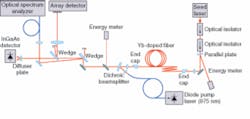FIBER AMPLIFIERS: Fiber design combines short pulses with high repetition rate and high beam quality
Numerous laser applications require nanosecond-duration pulses with high repetition rate (1 to 100 kHz), moderate pulse energy (0.1 to 10 mJ), linear polarization, and diffraction-limited beam quality. Examples include materials processing, remote sensing, chemical detection, and nonlinear frequency conversion. The ability to vary the repetition rate while maintaining constant values for the other optical parameters is highly desirable; but conventional Q-switched solid-state lasers are limited in this regard by an inherent coupling of the repetition rate to the pulse duration and beam quality.
Typically, increasing the repetition rate causes a concomitant increase in pulse duration because the gain does not fully recover between pulses. In addition, a degradation in beam quality (increase in M2) occurs because of thermal effects in the gain medium. Researchers at Sandia National Laboratories (Livermore, CA) and Teem Photonics (Meylan, France) have addressed these problems by seeding a mode-filtered, Yb-doped fiber amplifier with a passively Q-switched, Nd:YAG microchip laser (see figure). The researchers discussed the technology last month during a technical presentation at the annual Conference on Lasers and Electro Optics (CLEO) in Baltimore, MD.
Achieving stable operation
The 1064 nm microchip seed laser is pumped by an 808 nm, fiber-coupled diode laser.1 By optimizing the pump-beam focusing and heat-sinking of the microchip, the researchers achieve stable operation (timing jitter less than 0.5%) over a wide range of repetition rates (up to 27 kHz) with constant pulse duration (1.0 ±0.1 ns) and pulse energy (3.2 ±0.3 µJ). The approach is restricted to low pulse energies, but this limitation is acceptable because of the high gain of the fiber amplifier, according to Dahv Kliner, a member of the research team at Sandia.
The fiber amplifier uses polarization-maintaining, double-clad fiber with a 30 µm core diameter (approximately 14 guided modes). The gain fiber is coiled with a 3.5 cm bend radius to suppress high-order modes, and it is end-pumped by the 976 nm output of a formatted, fiber-coupled diode bar.
The laser system provides pulses with a tunable repetition rate of from 7.1 to 27 kHz and with constant pulse duration (1.1 ns), constant pulse energy (up to 0.41 mJ, or roughly 270 kW peak power), linear output polarization (more than 22 dB polarization extinction ratio), diffraction-limited beam quality (M2 less than 1.2), and less than 1% pulse-energy fluctuations. “These specifications are already useful for materials processing and other applications, and further power scaling is possible by increasing the repetition rate and/or pulse energy,” Kliner said.
“The high peak power and diffraction-limited beam quality of the mode-filtered fiber amplifier make this system ideal for pumping nonlinear optical interactions,” he added. “We frequency-converted the amplifier output to efficiently generate radiation from the mid-IR through the deep-UV (4400 to 213 nm), with watt-level output powers. Visible and UV radiation (532 to 213 nm) was obtained by generating the second, third, fourth, and fifth harmonics of the amplified 1064 nm pulses using LBO and BBO crystals (similar to those used in industrial laser systems).”
The frequency-conversion stages use a simple optical setup (a single lens and a single pass through the crystals), and further optimization is possible, Kliner said. The researchers achieve conversion efficiencies of 74% for 1064 to 532 nm and 37% for 532 to 266 nm. Near-IR (1400-1700 nm) and mid-IR (2800-4400 nm) radiation is generated by pumping an optical parametric generator based on a multiperiod, periodically poled, LiNbO3 crystal. Up to 55% conversion efficiency is achieved within the crystal.
“The system architecture employs passive Q-switching (no high-speed electronics), single-stage single-pass amplification, and CW pumping of both the oscillator and amplifier, thus offering high efficiency, simplicity, and compact, rugged packaging,” Kliner said.
REFERENCE
1. P.E. Schrader, R.L. Farrow, D.A.V. Kliner, et al., Optics Express 14(24) 11528 (Nov. 27, 2006.)
About the Author
Hassaun A. Jones-Bey
Senior Editor and Freelance Writer
Hassaun A. Jones-Bey was a senior editor and then freelance writer for Laser Focus World.
